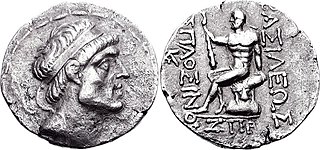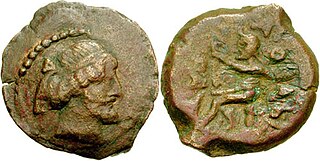
Characene, also known as Mesene (Μεσσήνη) or Meshan, was a kingdom founded by the Iranian Hyspaosines located at the head of the Persian Gulf mostly within modern day Iraq. Its capital, Charax Spasinou, was an important port for trade between Mesopotamia and India, and also provided port facilities for the city of Susa further up the Karun River. The kingdom was frequently a vassal of the Parthian Empire. Characene was mainly populated by Arabs, who spoke Aramaic as their cultural language. All rulers of the principality had Iranian names. Members of the Arsacid dynasty also ruled the state.

Abinergaos I, also known as Abinerglus, was the king of Characene starting in the second decade of the Christian era.

Apodakos was a king of Characene, a kingdom presumably vassal of the Parthian Empire.

Hyspaosines was an Iranian prince, and the founder of Characene, a kingdom situated in southern Mesopotamia. He was originally a Seleucid satrap installed by king Antiochus IV Epiphanes, but declared independence in 141 BC after the collapse and subsequent transfer of Seleucid authority in Iran and Babylonia to the Parthians. Hyspaosines briefly occupied the Parthian city of Babylon in 127 BC, where he is recorded in records as king (šarru). In 124 BC, however, he was forced to acknowledge Parthian suzerainty. He died in the same year, and was succeeded by his juvenile son Apodakos.

Tiraios I was a king from 95/94 BC to 90/89 BC of Characene, a vassal state of the Parthians.

Tiraios II was a king who ruled from about 79/78 to 49/48 BC the state of Characene, a vassal state of the Parthians.

Artabazos I of Characene was a king of Characene, a vassal state of the Parthians, His short reign lasted only from 49/48-48/47 BC.

Theonesios I was a King of Characene, a vassal state of the Parthian empire and important trading port on the Persian Gulf. His rule was from 25/24BC to 19/18BC.

Attambelos II was a king of Characene, a Parthian vassal state and important trading port on the Persian Gulf. His rule was from 17/16 to 9/8BC.

Attambelos VII was a king of Characene, a vassal state of the Parthians and important trading port. His short reign lasted from 113/4 to 116/7 AD and was spent mostly contending with the Roman invasion under Trajan.

Maga was a King of Characene a vassal state of the Parthian Empire and important trading city in the Persian Gulf.

Orabazes II was a king of Characene a kingdom located at the head of the Persian Gulf. His reign was from 150/51 to 165. He was most likely a relative of the Parthian king Vologases IV.

Abinergaios II was a ruler of Characene, an ancient kingdom located at the head of the Persian Gulf in modern Iraq. He reigned around 170 AD and like most Characene rulers he is known only from his coins, on which the spelling of his name varies.

Attambelos III of Characene was a king of Characene who ruled from approximately 37/38 to 44/45AD. His rule is known only by the coins he minted. The presence of these coins as far afield as Oman and southern Arabia indicates that his rule saw a time of extensive trade.

Attambelos IV of Characene was a first century ruler of the state of Characene, centered on the northern end of the Persian Gulf. His capital was probably Charax.

Attambelos V of Characene was a ruler of the state of Characene who ruled from 64/65–73/74 but who is known only from the coins he minted.

Attambelos VI of Characene was a ruler of the state of Characene, who ruled from approximately 101/02-105/06 and is known only from the coins he minted.

Theonesios III of Characene was a king of Characene who ruled from approximately 52AD. His rule is known only by the coins he minted.

Theonesios II of Characene was a 1st century king of the kingdom of Characene located at the mouth of the Tigris-Euphrates rivers during antiquity. He ruled for only a few months in 46/47AD. His rule is known only by the coins he minted.

Wahbarz, known in Greek sources as Oborzos, was a dynast (frataraka) of Persis in the 1st half of the 2nd century BC, ruling from possibly c. 205 to 164 BC. His reign was marked by his efforts to establish Persis as a kingdom independent from Seleucid authority. He was able to reign independently for three decades, and even expanded to the west, seizing the Seleucid province of Characene. In 164 BC, the Seleucids repelled Wahbarz's forces from Characene, forcing him to re-submit as a Seleucid vassal. He was succeeded by Baydad.













